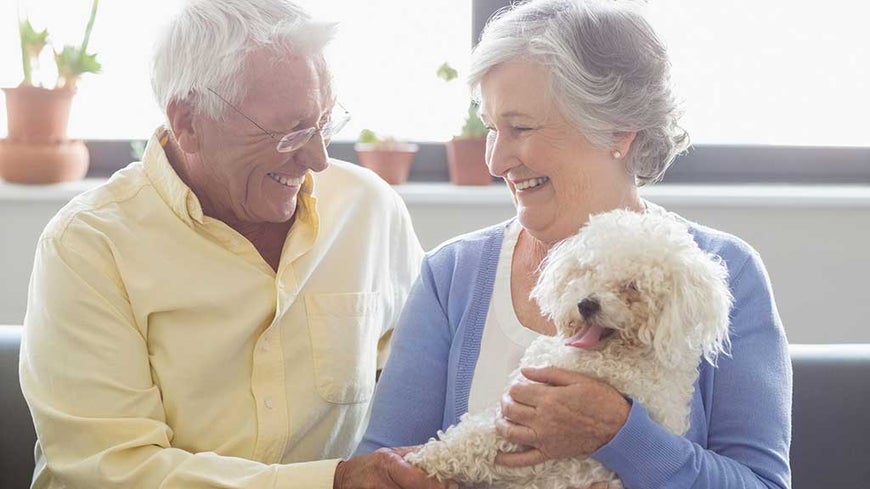The importance of pet insurance for over 50s

There are more than 24 million pets in Australia, which is one of the highest rates of pet ownership in the world.¹ But these pets often come at a significant cost, and that’s a major factor to consider for people deciding to adopt or purchase a pet.
It’s not just the initial outlay of money that seems to be concerning people. Australians are spending more than $12.2 billion annually on pet products and services.¹ Whilst most of this is spent on food, veterinary services are the second largest cost with $2.2 billion spent each year.¹
Protect yourself and your pet from the unexpected
Just like people, pets can get sick. When this happens, sometimes the costs for treatment can climb dramatically and become quite expensive depending on the issue relating to the animal.
Problems may arise when people do not consider the ongoing expenses associated with their new pet. One small accident can lead to major damage, that can see you spending thousands of dollars in health bills. Additionally, there are particular breeds of animals that may be more susceptible to health issues due to their genetic make-up.²
For some people, pet insurance is just another cost to add to the monthly spend, which may be a reason they choose not to take out cover. However, in the case of a sudden emergency or illness, or if your pet breed has known health issues, the cost of treatment can result in an expensive bill if you don’t have pet insurance.
Another element to consider is your projected cash flow. As an older Australian, you may be retired or be spending less time in active employment, meaning that unexpected bills can come as a major inconvenience.
Cats
Hundreds of thousands of Australian households have a cat, or more than one cat, as a pet. This shows that Australians love and value their feline companions and count them as part of the family.
The average lifespan of a cat is 12–18 years³, but they can live up to 20 years.⁴ Over that time, RSPCA New South Wales estimates:
- That owners can spend up to $3,570 for the first year of cat ownership, for items including food, vaccinations and microchipping.
- Owners spend a minimum of $880 for each consecutive year of their cat’s life on veterinary bills, grooming, food and treatments; or over $15,000 over the lifetime of the cat.⁴
Dogs
Dogs are the most popular pet within Australia, with thousands of breeds represented and with more than a third (38 per cent) of households owning a dog. There are around 4.8 million pet dogs in Australia; securing them a place as our official favourite pet.
Dogs may live up to 20 years⁴, and the first-year investment that owners need to outlay varies depending on the dog’s age, breed, size, and previous accidents and illness.
you’re looking at an additional $910 per year minimum.⁴
Why own a pet?
When you’re past working age, or in your later years, pets can bring companionship and affection to your life. In fact, studies have shown that older people with pets display fewer health problems compared to their non-pet owning friends, especially in relation to blood pressure and cholesterol.⁵
One of the main reasons for this is because pets tend to keep our minds active and, in the case of dogs, our bodies moving, too. A study done at the University of Missouri found older people who are pet owners benefited greatly from pet ownership, mainly due to walking their dogs.⁶
Physically, dog ownership means more physical activity, which could equate to a lower body mass index. Mentally, there’s also a huge social benefit. Pets can relieve stress, alleviate boredom and provide excellent companionship. This is especially important for older Australians who might be a long distance from family and friends, as loneliness is a contributing factor to failing health.⁵ Research has shown owning a pet leads to less depression, and a greater ability to cope with grief, stress and loss.
Research has also proven a confirmed link between pet ownership and reduced risk of heart disease, as outlined in our recent article on the health benefits of older Australians owning a pet. Additional benefits include:
- Improved connection
- Reduced visits to the doctor
- Improved mood
- Increased socialisation
- Increased movement-based activities.
In order to afford your pet, forward planning and pet insurance are key, as while expenses can stay relatively the same, income tends to decline. While the continuous price of pet insurance may be another ongoing cost to maintain, if and when the time does come that your pet requires treatment, pet insurance will be there to help.
Advantages of pet insurance
There are several advantages to taking out Seniors Pet Insurance, these include:
- Vet bill cover – Your Seniors Pet Insurance policy will cover up to 80 per cent of eligible vet bills, ensuring your pet can receive quality health care whenever they are in need.*
- No excess – which means you can make multiple claims per year without worrying about paying an excess every time you visit the vet.*
- You choose your vet – just because you take out insurance doesn’t mean you lose the ability to choose the veterinarian who will care for your pet.
- Ongoing peace of mind – even as your pet ages, it will still be covered. You can get cover for your pet when it’s as young as eight weeks old.
To find out more about how Australian Seniors can assist with the cost of providing care for your cat or dog, get a free quote for Pet Insurance today.
15 Mar 2018